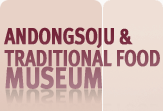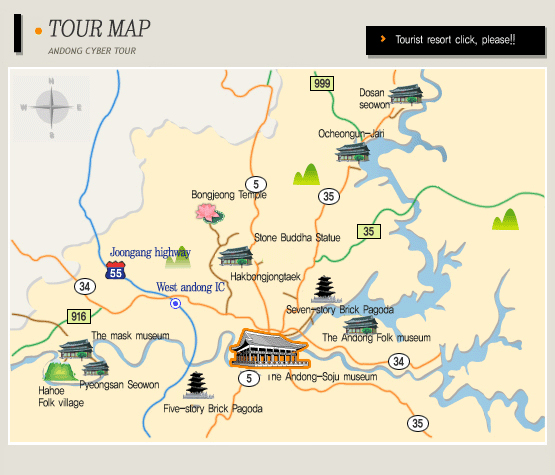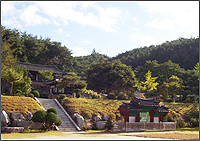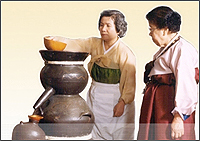|
|
|
 |
|
|
| < |
|

| Home < information
< Sight spots in the neighborhood |
|
 |

|
 |
 |
| This
is established for commemorating the
pre-eminent confucian scholar, Hwang
Lee. He set up Dosan Seodang; and after
his death, his disciples and scholars
established the Dosan Seowon. It is
located on the upper reaches of the
Naktong river. There used to be a lot
of kilns, so the place name, Dosan,
is derived from this historical fact.
In Chinese characters Dosan means the
pottery mountain. the Dosan Seowon is
surrounded by modest mountains and the
atmosphere is so serene and calm that
it is considered as a good place to
study. |
 |
 |
| Great
numbers of tourists visit Pyeongsan
Seowon which is known to possess the
most developed Seowon building construction
techniques. This pace was established
to commemorate Ryu Seongryong. Beyond
MT. Hwa from Hahoe village, Pyeongsan
Seowon, standing opposite a rock cliff
encircled by the Naktong River, boasts
its beautiful scenery and excellent
architecture. |
 |
 |
| This
is the great-historical village whose
main habitants are the Pungsan 'Ryu'
clan. There are a lot of well-preserved
cultural practices, so that it is considered
as an important source for folklore
material No.122. The Naktong river flows
around the village in an S-shape. We
can experience the way the ancestors
did by visiting the traditional structures
such as Choonhyodang and Yangjindang
and enjoying folk performances such
as Hahoe-byeolsingutnori. |
 |
 |
| This
is set up by Kim Dongpyo, the handicraftsman
of Hahoe masks, in 1981. He is using
this as a study room and manufactory.
He had learnt drawing and woodcraft
from a master in 1976. He opened this
museum in Hahoe-dong in 1981. |
 |
 |
|
In the 12th year of the reign of King
munmu of the Shila Dynasty, Monk neungindaeduk
established the temple. There is a legend
that he flew a paper dupe to the sky
and the temple was constructed on the
site where the paper dupe was placed,
and was called Bongjeong Temple. It
contains many cultural properties such
as Keukrakjeon, the oldest wooden building
in Korea. And Yeongsanam is famous as
the background of a Korean film. Elizabeth
the 2nd visited there recently. |
 |
 |
There
is a Gun-Jari halfway up the mountain.
It is famous for the natural beauty
of an area. This site has two floors.
On the first floor, there is a parking
lot. On the second floor, there are
well-organized principal buildings of
the gwangsan 'Kim' clan.
|
 |
 |
|
Stone Buddha Statue in Icheon-dong,
called 'jebiwonseokbul', is located
at the site of the Yeonmi temple. It
is very unique because the buddhist
head statue, made separately, is put
on the body. Unfortunately the head
is damaged. |
 |
 |
| Kim
Sungil whose pen name is Hakbong used
to live in this house. He is one of
the disciple of Toegye and is well versed
in the study of Seongri. After passing
the civil service examination of junggwang
in 1568, he successively held various
Government posts. He went to the Ming
as Seojanggwan of Saeunsa in 1557 and
Japan as Tongsinsa in 1590. He died
from an illness when Japan invaded the
Joseon dynasty, during which time he
was active in encouraging people to
fight against them. |
 |
 |
| Treasure
No. 16. This from the Unified Shila
Dynasty, located in beopheung-dong,
is the biggest and oldest brick pagoda
in Korea. It is 17m in height and the
base part is 7.5m. We can presume that
it is a part of the beopheung temple
which is established in the Unified
Shila Dynasty because the located area
is called 'Beopheung-ri'. |
 |
 |
| The
Andong Folk museum puts the ceremonies
of coming of age, marriage, funeral
and ancestral worship and collection
of folk material on display. there are
ancient structures and Seokbinggo which
were removed from submerged districts
in the outdoor museum. Wolyeonggyo and
KBS soap-opera outdoor studio are in
the neighbor. This is an educational
facility to help people understand the
local culture correctly and a resting
place of people of Andong. |
 |
 |
| The
Andong-Soju museum was founded to publicize
the history and cultural importance
of Andong-Soju on the 20th of November
in 2000. The origin and a manufacturing
process of Andong-Soju, a description
and a genealogical record of traditional
Korean liquors, and a display of liquor
bottles in chronological order are on
exhibition in the museum. The museum
has a place where people can experience
how to make Andong-Soju, and a tasting
room. |
 |
 |
| This
pagoda from the Unified Shila Dynasty
is 8.65m in height. Any remains of temples
are not found near this pagoda. A distinguishing
feature of it is that the first base
body is made of granite. |
|
|
|
|
|
|
|